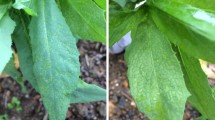Abstract
Hippeastrum chlorotic ringspot virus (HCRV) is a novel tospovirus that was identified in Yunnan Province, China, in 2013. We have sequenced the HCRV L gene, which is 8909 nt long and encodes the RNA-dependent RNA polymerase (2873 amino acids, 330.8 kDa). The HCRV L protein shared highest similarity (89.4 %) with that of tomato yellow ring virus. The L protein contains a negative-sense RNA virus RNA-directed RNA polymerase motif and an endonuclease domain at the N-terminus. Combined with our previous reports of the S and M RNAs, the genome sequence of HCRV is now completed.

Similar content being viewed by others
References
Arnold K, Bordoli L, Kopp J, Schwede T (2006) The SWISS-MODEL workspace: a web-based environment for protein structure homology modelling. Bioinformatics 22:195–201
Bordoli L, Kiefer F, Arnold K, Benkert P, Battey J, Schwede T (2008) Protein structure homology modeling using SWISS-MODEL workspace. Nat Protoc 4:1–13
Dong J, Cheng X, Yin Y, Fang Q, Ding M, Li T, Zhang L, Su X, McBeath JH, Zhang Z-K (2008) Characterization of tomato zonate spot virus, a new tospovirus in China. Arch Virol 153:855–864
Dong J, Yin Y, Fang Q, Mcbeath J, Zhang Z (2013) A new tospovirus causing chlorotic ringspot on Hippeastrum sp. in China. Virus Genes 46:567–570
Guex N, Peitsch MC (1997) SWISS-MODEL and the Swiss-PDB Viewer: an environment for comparative protein modeling. Electrophoresis 18:2714–2723
Hu Z, Feng Z, Zhang Z, Liu Y, Tao X (2011) Complete genome sequence of a tomato spotted wilt virus isolate from China and comparison to other TSWV isolates of different geographic origin. Arch Virol 156:1905–1908
Kiefer F, Arnold K, Künzli M, Bordoli L, Schwede T (2009) The SWISS-MODEL repository and associated resources. Nucleic Acids Res 37:D387–D392
Liu Y, Zheng Y, Li Y, Li Z (2010) First report of impatiens necrotic spot virus on Spiderlily in China. Plant Dis 94:484
Liu Z, Li Y, Wu Y, Rao X (2010) Identification of Tospovirus on pepper in Guangzhou. Acta Phytophylacica Sinica 4:020
Pappu H, Jones R, Jain R (2009) Global status of tospovirus epidemics in diverse cropping systems: successes achieved and challenges ahead. Virus Res 141:219–236
Quevillon E, Silventoinen V, Pillai S, Harte N, Mulder N, Apweiler R, Lopez R (2005) InterProScan: protein domains identifier. Nucleic Acids Res 33:W116–W120
Reguera J, Weber F, Cusack S (2010) Bunyaviridae RNA polymerases (L-protein) have an N-terminal, influenza-like endonuclease domain, essential for viral cap-dependent transcription. PLoS Pathog 6:e1001101
Xu Y, Lou S, Li X, Zheng Y, Wang W, Liu Y (2013) The complete S RNA and M RNA nucleotide sequences of a hippeastrum chlorotic ringspot virus (HCRV) isolate from Hymenocallis littoralis (Jacq.) Salisb in China. Arch Virol 158:2597–2601
Zdobnov EM, Apweiler R (2001) InterProScan—an integration platform for the signature-recognition methods in InterPro. Bioinformatics 17:847–848
Zhang Z, Ding M, Fang Q, Zhang L, Li T, Peng L, Su X, Li Z (2004) The preliminary study of the occurrence and distribution of Tospovirus in Yunnan. Southwest China J Agric Sci S1:163–168
Acknowledgments
This work was supported by the National Science Foundation of China (No. 31260451 & 30960224), a Project on Social Development by the Department of Science and Technology of Yunnan Province, National Undergraduate Training Programs for Innovation and Entrepreneurship (201210676006), and Yunnan Undergraduate Training Programs for Innovation and Entrepreneurship (DC0001).
Conflict of interest
The authors have no conflicts of interest to declare.
Author information
Authors and Affiliations
Corresponding author
Additional information
Y. Xu and S. Lou contributed equally to this work.
The nucleotide sequence data reported in this manuscript have been deposited at the EMBL under accession No. HG763861.
Electronic supplementary material
Below is the link to the electronic supplementary material.
Rights and permissions
About this article
Cite this article
Xu, Y., Lou, Sg., Li, Qf. et al. Molecular characterization of the hippeastrum chlorotic ringspot virus L segment and its protein. Arch Virol 159, 2805–2807 (2014). https://doi.org/10.1007/s00705-014-2100-9
Received:
Accepted:
Published:
Issue Date:
DOI: https://doi.org/10.1007/s00705-014-2100-9




